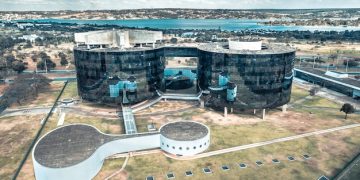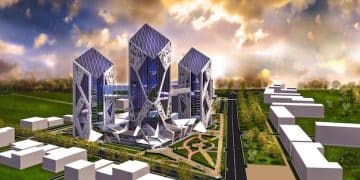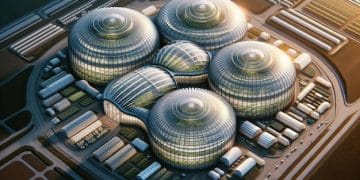Are SMRs the US Energy Solution by 2027? A Deep Dive
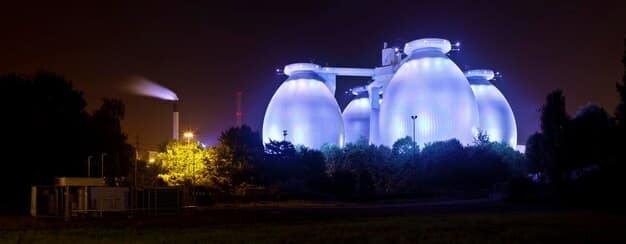
Small Modular Reactors (SMRs) are being explored as a solution for U.S. energy needs by 2027, offering potential benefits like reduced construction time, enhanced safety features, and flexible deployment options; however, challenges remain regarding regulatory approval, cost competitiveness, and public perception, impacting their viability.
Are Small Modular Reactors (SMRs) a Viable Solution for US Energy Needs by 2027? As the United States seeks to modernize its energy infrastructure and reduce its carbon footprint, this question becomes increasingly pertinent.
The Promise of Small Modular Reactors (SMRs)
Small Modular Reactors (SMRs) are gaining attention as a potential game-changer in the energy sector. These advanced nuclear reactors offer a new approach to nuclear power, promising greater flexibility, enhanced safety, and reduced capital investment.
What Are Small Modular Reactors?
Unlike traditional large-scale nuclear power plants, SMRs are smaller, typically generating up to 300 MW of electricity. Their modular design allows for factory fabrication and on-site assembly, potentially reducing construction time and costs.
Key Advantages of SMRs
SMRs offer several advantages over traditional nuclear reactors, including enhanced safety features, reduced environmental impact, and greater flexibility in deployment. Their smaller size also makes them suitable for a wider range of locations, including remote areas and industrial sites.
- Enhanced Safety: SMRs incorporate passive safety systems that rely on natural forces like gravity and convection to shut down the reactor in case of an emergency, reducing the risk of accidents.
- Reduced Environmental Impact: SMRs produce minimal greenhouse gas emissions during operation, contributing to a cleaner energy mix.
- Flexible Deployment: SMRs can be deployed in a variety of settings, including urban areas, industrial facilities, and remote communities, providing a reliable source of power where it’s needed most.
The promise of SMRs lies in their potential to provide a safe, clean, and reliable source of energy for the United States. However, realizing this potential requires addressing several challenges and overcoming significant hurdles.
US Energy Needs and the Role of Nuclear Power
To understand the viability of SMRs, it’s crucial to examine the energy needs of the United States and the role that nuclear power currently plays in meeting those needs. The U.S. relies on a diverse mix of energy sources, including fossil fuels, nuclear power, and renewable energy.
Current Energy Landscape
Fossil fuels, such as natural gas and coal, still dominate the U.S. energy mix, but their contribution is gradually declining as renewable energy sources gain market share. Nuclear power currently accounts for about 20% of the nation’s electricity generation.
The Need for Clean Energy Solutions
As concerns about climate change grow, there is increasing pressure to transition to cleaner energy sources. Nuclear power, with its minimal greenhouse gas emissions, is seen by some as a crucial component of a low-carbon energy future. However, the high cost and long construction times of traditional nuclear power plants have hindered its growth.
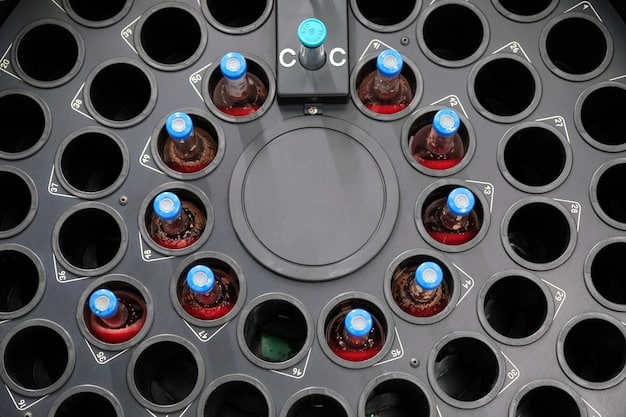
Nuclear Power’s Existing Contribution
Existing nuclear power plants provide a significant amount of baseload power in the U.S., meaning they operate continuously, providing a reliable supply of electricity. The challenge is to maintain and modernize this existing infrastructure while also exploring new nuclear technologies like SMRs.
The U.S. energy landscape is evolving rapidly, with increasing demand for clean, reliable, and affordable energy. Nuclear power, including SMRs, has the potential to play a significant role in meeting these needs, but it must overcome challenges related to cost, safety, and public acceptance.
SMR Technology and Design Innovations
SMRs are not simply scaled-down versions of traditional nuclear reactors; they incorporate numerous technological and design innovations aimed at improving safety, reducing costs, and enhancing performance. These innovations are key to their potential viability.
Passive Safety Systems
One of the most significant advancements in SMR technology is the incorporation of passive safety systems. These systems rely on natural forces, such as gravity, convection, and natural circulation, to shut down the reactor in the event of an emergency, without the need for human intervention or external power sources.
Modular Design and Construction
SMRs are designed to be manufactured in factories and shipped to the deployment site, reducing construction time and costs. This modular approach also allows for greater flexibility in siting and deployment.

Advanced Fuel Cycles
Some SMR designs incorporate advanced fuel cycles that can improve fuel utilization, reduce waste, and enhance safety. These advanced fuels may also be more resistant to proliferation, reducing the risk of nuclear materials being used for weapons.
SMR technology is rapidly evolving, with ongoing research and development efforts focused on further improving safety, reducing costs, and enhancing performance. These innovations are essential for making SMRs a viable solution for U.S. energy needs.
Challenges and Obstacles to SMR Deployment by 2027
Despite the promise of SMRs, several challenges and obstacles must be overcome for them to be a viable solution for U.S. energy needs by 2027. These challenges include regulatory hurdles, cost competitiveness, and public acceptance.
Regulatory Approval
The regulatory approval process for nuclear power plants in the U.S. is complex and time-consuming. SMRs must undergo rigorous safety reviews and environmental assessments before they can be licensed for operation. Streamlining the regulatory process without compromising safety is crucial for accelerating SMR deployment.
Cost Competitiveness
The cost of building and operating nuclear power plants has been a major barrier to their growth. SMRs must be cost-competitive with other energy sources, such as natural gas and renewable energy, to be commercially viable. Reducing construction costs and improving operational efficiency are essential for achieving cost competitiveness.
- Construction Costs: Streamlining the modular construction process can significantly reduce construction costs.
- Operational Efficiency: Optimizing the design and operation of SMRs can improve efficiency and reduce operating costs.
- Financing: Government support and innovative financing mechanisms can help reduce the financial burden of SMR projects.
Public Acceptance
Public perception of nuclear power is often negative, due to concerns about safety and waste disposal. Overcoming these concerns and building public trust are essential for gaining support for SMR deployment. Transparent communication and community engagement can help address public concerns.
The path to SMR deployment in the U.S. is not without its challenges. Addressing these challenges head-on and working collaboratively with regulators, industry, and the public are essential for realizing the potential of SMRs to contribute to a cleaner and more secure energy future.
Economic and Environmental Considerations
Beyond the technical aspects, the economic and environmental implications of SMR deployment must be carefully considered. These factors will play a significant role in determining the viability of SMRs as a solution for U.S. energy needs.
Economic Benefits
SMR projects can create jobs in manufacturing, construction, and operation. They can also boost local economies by providing a reliable source of energy and stimulating economic development.
Environmental Impact
SMRs produce minimal greenhouse gas emissions during operation, contributing to a cleaner energy mix. However, the environmental impact of uranium mining and waste disposal must also be considered.
Life Cycle Assessment
A comprehensive life cycle assessment can help evaluate the overall environmental impact of SMRs, from uranium mining to waste disposal. This assessment should consider all stages of the nuclear fuel cycle and compare the environmental impact of SMRs to other energy sources.
The economic and environmental considerations surrounding SMR deployment are complex and multifaceted. A balanced approach that considers both the benefits and the costs is essential for making informed decisions about the role of SMRs in the U.S. energy future.
The Future of SMRs in the US Energy Mix
Looking ahead, the future of SMRs in the U.S. energy mix depends on several factors, including technological advancements, policy support, and market conditions. If these factors align favorably, SMRs could play a significant role in decarbonizing the U.S. economy and ensuring a reliable energy supply.
Policy and Regulatory Support
Government policies and regulations can play a crucial role in promoting SMR deployment. Incentives such as tax credits, loan guarantees, and streamlined regulatory processes can help reduce the financial and regulatory barriers to SMR deployment.
Market Opportunities
SMRs have the potential to serve a wide range of market segments, including utilities, industrial facilities, and remote communities. Identifying and capitalizing on these market opportunities is essential for the commercial success of SMRs.
- Grid Modernization: SMRs can provide flexible and reliable power to support grid modernization efforts.
- Industrial Applications: SMRs can provide heat and electricity for industrial processes, reducing reliance on fossil fuels.
- Remote Communities: SMRs can provide a reliable source of power for remote communities that are not connected to the main grid.
International Collaboration
International collaboration on SMR development and deployment can help accelerate innovation, reduce costs, and enhance safety. Sharing knowledge and best practices with other countries can also help build public confidence in SMR technology.
The future of SMRs in the U.S. energy mix is uncertain, but their potential to provide a safe, clean, and reliable source of energy is undeniable. By addressing the challenges and capitalizing on the opportunities, SMRs could play a significant role in shaping the U.S. energy landscape for decades to come.
| Key Point | Brief Description |
|---|---|
| 💡 SMR Advantages | Enhanced safety, reduced environmental impact, and flexible deployment. |
| 🚧 SMR Challenges | Regulatory hurdles, cost competitiveness, and public acceptance. |
| 🌎 Environmental Impact | Minimal greenhouse gas emissions during operation, need for life cycle assessments. |
| 💰 Economic Factors | Job creation, economic development, and reduction of financial barriers. |
Frequently Asked Questions (FAQ)
▼
Small Modular Reactors (SMRs) are advanced nuclear reactors that are smaller in size compared to traditional nuclear reactors. They aim for the efficiency of being factory-fabricated and assembled on-site, leading to faster construction.
▼
SMRs incorporate passive safety systems that depend on natural forces like gravity and convection for emergencies. This reduces the need for active intervention, thus lowering the risk of accidents.
▼
Deployment obstacles include navigating complex regulatory approvals, achieving cost competitiveness with other energy sources, and building public trust and acceptance of nuclear technology.
▼
SMR projects can create jobs across various sectors like manufacturing, construction, and operation. They also tend to boost local economies by providing reliable energy and stimulating further economic development.
▼
Government policies like tax credits, loan guarantees, and streamlined regulatory processes can significantly promote the deployment and integration of SMRs by reducing both financial and regulatory hurdles.
Conclusion
In conclusion, while Small Modular Reactors (SMRs) hold promise for meeting U.S. energy needs by 2027 with their enhanced safety features and modular design, significant challenges related to regulatory approval, cost competitiveness, and public perception must be addressed to ensure their viability and successful integration into the nation’s energy mix.
